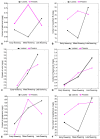Phenological Variations in the Content of Polyphenols and Triterpenoids in Epilobium angustifolium Herb Originating from Ukraine
- PMID: 38202428
- PMCID: PMC10781012
- DOI: 10.3390/plants13010120
Phenological Variations in the Content of Polyphenols and Triterpenoids in Epilobium angustifolium Herb Originating from Ukraine
Abstract
The composition of secondary metabolites undergoes significant changes in plants depending on the growth phase and the influence of environmental factors. Therefore, it is important to determine the harvesting time of plant material for the optimum secondary metabolite profile and therapeutic activity of the primary material. The shoots of Epilobium angustifolium are used as a healing tea due to the presence of polyphenolic compounds. The aim of this study was to assess the composition of phenolic compounds and triterpenoid saponins in E. angustifolium leaves and flowers and to estimate the dynamics of their content depending on the flowering phase. Qualitative and quantitative characterisation of polyphenols and triterpenoids in E. angustifolium samples from Ukraine of three flowering phases were performed using the high-performance liquid chromatography photo diode array (HPLC-PDA) method. During the present study, 13 polyphenolic compounds and seven triterpenoids were identified in the plant material. It was noted that the largest content and the best polyphenol profile was in late flowering. The most important polyphenolic compounds in the plant material were chlorogenic acid, hyperoside, isoquercitin, and oenothein B. The triterpenoid profile was at its maximum during mass flowering, with corosolic and ursolic acids being the dominant metabolites. The results of the analysis revealed that the quantity of many of the tested metabolites in the raw material of E. angustifolium is dependent on the plant organ and flowering phase. The largest content of most metabolites in the leaves was in late flowering. In the flowers, the quantity of the metabolites studied was more variable, but decreased during mass flowering and increased significantly again in late flowering. The results show that E. angustifolium raw material is a potential source of oenothein B and triterpenoids.
Keywords: Chamaenerion angustifolium; biologically active compounds; flowering phase; phenology.
Conflict of interest statement
The authors declare no conflicts of interest.
Figures





Similar articles
-
Inter-population and inter-organ distribution of the main polyphenolic compounds of Epilobium angustifolium.Phytochemistry. 2017 Feb;134:54-63. doi: 10.1016/j.phytochem.2016.11.003. Epub 2016 Nov 17. Phytochemistry. 2017. PMID: 27866749
-
Therapeutic Potential of Polyphenols from Epilobium Angustifolium (Fireweed).Phytother Res. 2016 Aug;30(8):1287-97. doi: 10.1002/ptr.5648. Epub 2016 May 24. Phytother Res. 2016. PMID: 27215200 Free PMC article. Review.
-
In vivo bioactivity assessment on Epilobium species: A particular focus on Epilobium angustifolium and its components on enzymes connected with the healing process.J Ethnopharmacol. 2020 Nov 15;262:113207. doi: 10.1016/j.jep.2020.113207. Epub 2020 Jul 27. J Ethnopharmacol. 2020. PMID: 32730870
-
Assessment of the Phenolics Content in Epilobium angustifolium and Epilobium hirsutum Extracts and Their Pharmacological Activity.Arch Pharm (Weinheim). 2025 May;358(5):e12001. doi: 10.1002/ardp.202400765. Arch Pharm (Weinheim). 2025. PMID: 40359335
-
Epilobium angustifolium L. as a Potential Herbal Component of Topical Products for Skin Care and Treatment-A Review.Molecules. 2022 May 31;27(11):3536. doi: 10.3390/molecules27113536. Molecules. 2022. PMID: 35684473 Free PMC article. Review.
Cited by
-
The phenology of Epilobium hirsutum L.: assessing marker compounds variability of a pharmaceutically important plant remedy.Front Pharmacol. 2025 Jul 15;16:1602819. doi: 10.3389/fphar.2025.1602819. eCollection 2025. Front Pharmacol. 2025. PMID: 40735479 Free PMC article.
-
Phenolic Compounds and Pharmacological Potential of Lavandula angustifolia Extracts for the Treatment of Neurodegenerative Diseases.Plants (Basel). 2025 Jan 20;14(2):289. doi: 10.3390/plants14020289. Plants (Basel). 2025. PMID: 39861644 Free PMC article.
-
Efficacy of Willow Herb (Epilobium angustifolium L. and E. parviflorum Schreb.) Crude and Purified Extracts and Oenothein B Against Prostatic Pathogens.Antibiotics (Basel). 2025 Jan 23;14(2):117. doi: 10.3390/antibiotics14020117. Antibiotics (Basel). 2025. PMID: 40001361 Free PMC article.
References
-
- Stace C. New Flora of the British Isles. 4th ed. C&M Floristics; Iver, UK: 2019. p. 1266.
-
- Wagner W.L., Hoch P.C., Raven P.H. Revised classification of the Onagraceae. Syst. Bot. Monogr. 2007;83:1–240.
-
- Sõukand R., Pieroni A., Biró M., Dénes A., Dogan Y., Hajdari A., Kalle R., Reade B., Mustafa B., Nedelcheva A., et al. An ethnobotanical perspective on traditional fermented plant foods and beverages in Eastern Europe. J. Ethnopharmacol. 2015;170:284–296. doi: 10.1016/j.jep.2015.05.018. - DOI - PubMed
-
- Karakaya S., Süntar I., Yakinci O.F., Sytar O., Ceribasi S., Dursunoglu B., Ozbek H., Guvenalp Z. In vivo bioactivity assessment on Epilobium species: A particular focus on Epilobium angustifolium and its components on enzymes connected with the healing process. J. Ethnopharmacol. 2020;262:113207–113220. doi: 10.1016/j.jep.2020.113207. - DOI - PubMed
LinkOut - more resources
Full Text Sources

